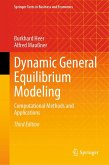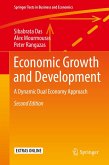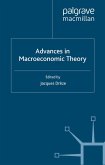Modern business cycle theory and growth theory uses stochastic dynamic general equilibrium models. In order to solve these models, economists need to use many mathematical tools. This book presents various methods in order to compute the dynamics of general equilibrium models.
In part I, the representative-agent stochastic growth model is solved with the help of value function iteration, linear and linear quadratic approximation methods, parameterised expectations and projection methods. In order to apply these methods, fundamentals from numerical analysis are reviewed in detail.
In part II, the authors discuss methods in order to solve heterogeneous-agent economies. This part of the book also serves as an introduction to the modern theory of distribution economics. Applications include the dynamics of the income distribution over the business cycle or the demographic transition in a large-scale overlapping generations model.
In an accompanying home page to this book, computer codes to all applications can be downloaded.
"This is perhaps the perfect book to learn how to solve quantitative macroeconomics models. Its balance between theory, choice of models, computational insights and use of examples make it an excellent teaching tool. One of the very few books a professional macroeconomist should have: I always learn something important when I consult it." José-Víctor Ríos Rull, University of Minnesota
"This book not only does an excellent job in explaining the existing tools, but it also teaches the reader on how to write her/his own programs and it provides the reader with the tools to help advance the state of the art of dynamic macroeconomics. " Wouter J. Den Haan, University of Amsterdam
"This is an excellent book for economists who do quantitative research. It will be an invaluable teaching tool for graduate macroeconomic courses." Ayse Imrohoroglu, University of Southern California
"... provides the reader with exactly the necessary computational tools to solve the dynamic general equilibrium models macroeconomists care about. It is therefore the perfect complement to Stokey, Lucas and Prescott's and Sargent and Ljungqvist's theoretical treatment of modern macroeconomics." Dirk Krueger, University of Pennsylvania
In part I, the representative-agent stochastic growth model is solved with the help of value function iteration, linear and linear quadratic approximation methods, parameterised expectations and projection methods. In order to apply these methods, fundamentals from numerical analysis are reviewed in detail.
In part II, the authors discuss methods in order to solve heterogeneous-agent economies. This part of the book also serves as an introduction to the modern theory of distribution economics. Applications include the dynamics of the income distribution over the business cycle or the demographic transition in a large-scale overlapping generations model.
In an accompanying home page to this book, computer codes to all applications can be downloaded.
"This is perhaps the perfect book to learn how to solve quantitative macroeconomics models. Its balance between theory, choice of models, computational insights and use of examples make it an excellent teaching tool. One of the very few books a professional macroeconomist should have: I always learn something important when I consult it." José-Víctor Ríos Rull, University of Minnesota
"This book not only does an excellent job in explaining the existing tools, but it also teaches the reader on how to write her/his own programs and it provides the reader with the tools to help advance the state of the art of dynamic macroeconomics. " Wouter J. Den Haan, University of Amsterdam
"This is an excellent book for economists who do quantitative research. It will be an invaluable teaching tool for graduate macroeconomic courses." Ayse Imrohoroglu, University of Southern California
"... provides the reader with exactly the necessary computational tools to solve the dynamic general equilibrium models macroeconomists care about. It is therefore the perfect complement to Stokey, Lucas and Prescott's and Sargent and Ljungqvist's theoretical treatment of modern macroeconomics." Dirk Krueger, University of Pennsylvania
Dieser Download kann aus rechtlichen Gründen nur mit Rechnungsadresse in A, B, BG, CY, CZ, D, DK, EW, E, FIN, F, GR, HR, H, IRL, I, LT, L, LR, M, NL, PL, P, R, S, SLO, SK ausgeliefert werden.
From the reviews of the second edition:
"The book is devoted to the presentation of such methods applied to solving a variety of discrete stochastic and deterministic DGE models in infinite time horizon. The way the book is written enables to use it as a lecture book for courses on computational methods in macroeconomics or modern dynamic equilibrium modeling for graduate students. There are given many useful practical hints on using the methods in practice - this makes the book very valuable for practical users of DGE models." (Piotr Mackowiak, Zentralblatt MATH, Vol. 1200, 2011)
"The book is devoted to the presentation of such methods applied to solving a variety of discrete stochastic and deterministic DGE models in infinite time horizon. The way the book is written enables to use it as a lecture book for courses on computational methods in macroeconomics or modern dynamic equilibrium modeling for graduate students. There are given many useful practical hints on using the methods in practice - this makes the book very valuable for practical users of DGE models." (Piotr Mackowiak, Zentralblatt MATH, Vol. 1200, 2011)









